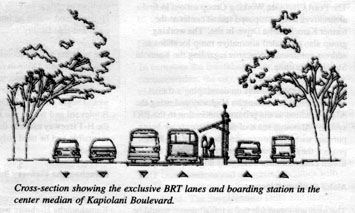|
Honolulu Advertiser Second Opinion column by Cliff Slater September 4, 2001 1 |
|
|
Footnotes: (1) For BRT details see: http://www.oahutrans2k.com
(2) In the late 1980s opinion polls on rail transit ran 60-40% in favor of rail. Over time, and as construction became imminent voters began to eventually understand that rail transit would not live up to its claims and would cost far more than was then being estimated. The more they knew, the less they liked it.
(3) Primary Corridor Transportation Project: Major Investment Study/Draft Environmental Impact Statement. City and County of Honolulu, Department of Transportation Services. August 2000. [Primary Corridor study]. P. S-1 & 3. (4) At present the six lanes along Kapiolani Boulevard are coned so that four lanes are town bound and two are Diamond Head bound. Coning will not be possible with the designation of the two center lanes for the BRT. See the City’s own cross section of Kapiolani below: (5) Primary Corridor Transportation Project: Major Investment Study/Draft Environmental Impact Statement. City and County of Honolulu, Department of Transportation Services. August 2000. [Primary Corridor study]. p. S-11. |
xCity's rapid transit vision will fadeElected officials will back off from plans for a Bus Rapid Transit system once they hear voters' objections. People often ask me why the City’s Bus Rapid Transit (BRT) vision(1) has not engaged my attention in the same way as did their last vision: heavy rail transit. It’s simple: I do not believe the BRT vision will survive beyond the next gubernatorial election. BRT’s sole purpose is to give the Mayor a little gravitas—to inculcate into the voters the idea that here is a man who can plan for more than fake rocks. The BRT vision serves to boost him up from his current levitas—the unbearable lightness of being Mayor, so to speak. Why will BRT not survive? Like last time around, voters will eventually wake up to the reality of this vision and reject it out of hand.(2) First you must understand that while BRT is rubber tired, it is like a streetcar in that it uses dedicated lanes in the middle of the streets. Thus, it embodies all the congestion causing drawbacks of a light rail line that Mayor Harris quite correctly opposed when he was promoting heavy rail transit. Strangely, planners aim is to reduce traffic congestion by making traffic congestion so bad that car drivers will be forced to ride the BRT. This will reduce traffic congestion, they say. (This has all the logic of Yogi Berra’s remark about Coney Island, "It’s so crowded, no one goes there anymore.") They are quite serious. Here’s what the planners say, “a key strategy to mitigate traffic congestion is to get people out of their cars. This requires that alternative modes such as walking, bicycling and using public transit be given priority” and that “the present automobile orientation must move to a more balanced mix of transportation modes.”(3) Take Kapiolani Boulevard during morning rush hour, for example. They plan to impropriate the two center lanes for the exclusive use of BRT leaving just two lanes town-bound for regular buses and autos instead of the current four lanes.(4) Traffic will also be held up while BRT passengers cross the street from the BRT islands. The planners freely admit that all this will create massive traffic congestion for autos and buses. They say clearly, “Most intersections within Downtown Honolulu and Waikiki would be subject to extreme congestion during peak periods. However, the exclusive BRT lanes would allow transit passengers on transit vehicles to avoid this congestion.”(5) In other words, they are going to force you onto BRT. Now the real question is, have other cities reduced traffic congestion with new kinds of government transit? No. Visionaries will ask but what about Portland’s MAX light rail? And San Jose’s light rail? And Sacramento’s rail line? Fortunately, we have a federally sponsored study by the Texas A&M Transportation Institute that has tracked U.S. traffic congestion annually since 1982 by calculating a Roadway Congestion Index for each major metropolitan area. Examining their results we find that before Portland opened its rail line in 1984, its Index was 0.81. From then on it has worsened each year—without exception—to the highly congested 1.24 level it is today (Honolulu is 1.06). There is absolutely no indication of its rail line ever having had any beneficial effect whatsoever. San Jose, which opened in 1987, had the same result. Sacramento, likewise. In fact, it is the same for any rail line opened during the 1980s and 90s for which we have the data. Check them yourself online at: http://mobility.tamu.edu/2001/study/cities/ Planners seem not to understand that the forgotten 90% of us using automobiles do it for good reason. And, rather than submissively follow the planners’ diktats to ride BRT, we will one day wake up to the idea of this new level of traffic congestion and go ballistic. This will frighten elected officials into believing they might be un-elected and that will be the end of BRT. I hope. Cliff Slater is a regular columnist whose footnoted columns are at: www.lava.net/cslater |
